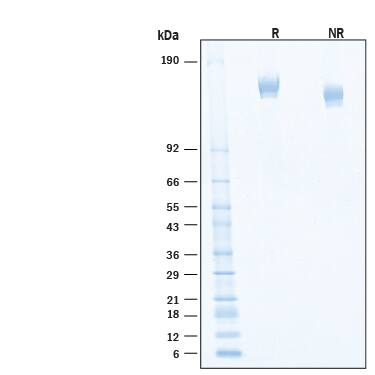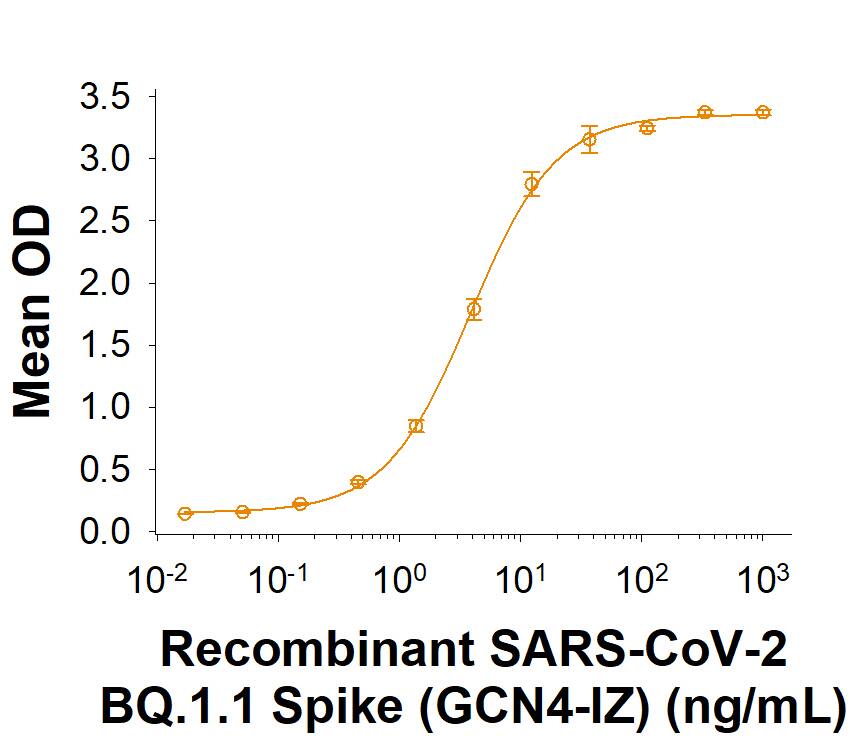Recombinant SARS-CoV-2 BQ.1.1 Spike GCN4-IZ His Protein, CF
R&D Systems, part of Bio-Techne | Catalog # 11359-CV

Key Product Details
Product Specifications
Source
SARS-COV-2 BQ.1.1 Spike |
HP | 2-GSL | GCN4-IZ | 2-GSL | 6-His tag |
| N-terminus | C-terminus | ||||
Purity
Endotoxin Level
N-terminal Sequence Analysis
Predicted Molecular Mass
SDS-PAGE
Activity
Scientific Data Images for Recombinant SARS-CoV-2 BQ.1.1 Spike GCN4-IZ His Protein, CF
Recombinant SARS-CoV-2 BQ.1.1 Spike (GCN4-IZ) His-tag Protein Binding Activity.
Recombinant SARS-CoV-2 BQ.1.1 Spike (GCN4-IZ) His-tag Protein (Catalog # 11359-CV) binds Recombinant Human ACE-2 Fc Chimera (10544-ZN) in a functional ELISA.Recombinant SARS-CoV-2 BQ.1.1 Spike (GCN4-IZ) His-tag Protein SDS-PAGE.
2 μg/lane of Recombinant SARS-CoV-2 BQ.1.1 Spike (GCN4-IZ) His-tag Protein (Catalog # 11359-CV) was resolved with SDS-PAGE under reducing (R) and non-reducing (NR) conditions and visualized by Coomassie® Blue staining, showing bands at 137-162 kDa.Formulation, Preparation and Storage
11359-CV
| Formulation | Lyophilized from a 0.2 μm filtered solution in PBS with Trehalose. |
| Reconstitution | Reconstitute at 500 μg/mL in PBS. |
| Shipping | The product is shipped at ambient temperature. Upon receipt, store it immediately at the temperature recommended below. |
| Stability & Storage | Use a manual defrost freezer and avoid repeated freeze-thaw cycles.
|
Background: Spike
References
- Wu, F. et al. (2020) Nature 579:265.
- Tortorici, M.A. and D. Veesler (2019) Adv. Virus Res. 105:93.
- Bosch, B.J. et al. (2003) J. Virol. 77:8801.
- Belouzard, S. et al. (2009) Proc. Natl. Acad. Sci. 106:5871.
- Millet, J.K. and G.R. Whittaker (2015) Virus Res. 202:120.
- Ortega, J.T. et al. (2020) EXCLI J. 19:410.
- Wang, K. et al. (2020) bioRxiv https://www.biorxiv.org/content/10.1101/2020.03.14.988345v1.
- Isabel, S. et al. (2020) Sci Rep. 10, 14031. https://doi.org/10.1038/s41598-020-70827-z.
- Tai, W. et al. (2020) Cell. Mol. Immunol. 17:613.
- Okba, N. M. A. et al. (2020). Emerg. Infect. Dis. https://doi.org/10.3201/eid2607.200841.
- Shah, M. and Woo, H.G. (2021) bioRxiv https://doi.org/10.1101/2021.12.04.471200.
- Lupala, C.S. et al. (2021) bioRxiv https://doi.org/10.1101/2021.12.10.472102.
- Zhang, L. et al. (2020) Nat Commun. 11:6013.
- Lasek-Nesselquist, E. et al. (2021) medRxiv https://doi.org/10.1101/2021.03.10.21253285.
- Scheepers, C. et al. (2021) medRxiv https://doi.org/10.1101/2021.08.20.21262342.
- Callaway, E. and Ledford, H. (2021) Nature 600:197.
- Kurhade,C.,et al.(2022) Nature Med. https://doi.org/10.1038/s41591-022-02162-x.
Long Name
Alternate Names
Entrez Gene IDs
Gene Symbol
UniProt
Additional Spike Products
Product Documents for Recombinant SARS-CoV-2 BQ.1.1 Spike GCN4-IZ His Protein, CF
Product Specific Notices for Recombinant SARS-CoV-2 BQ.1.1 Spike GCN4-IZ His Protein, CF
For research use only

